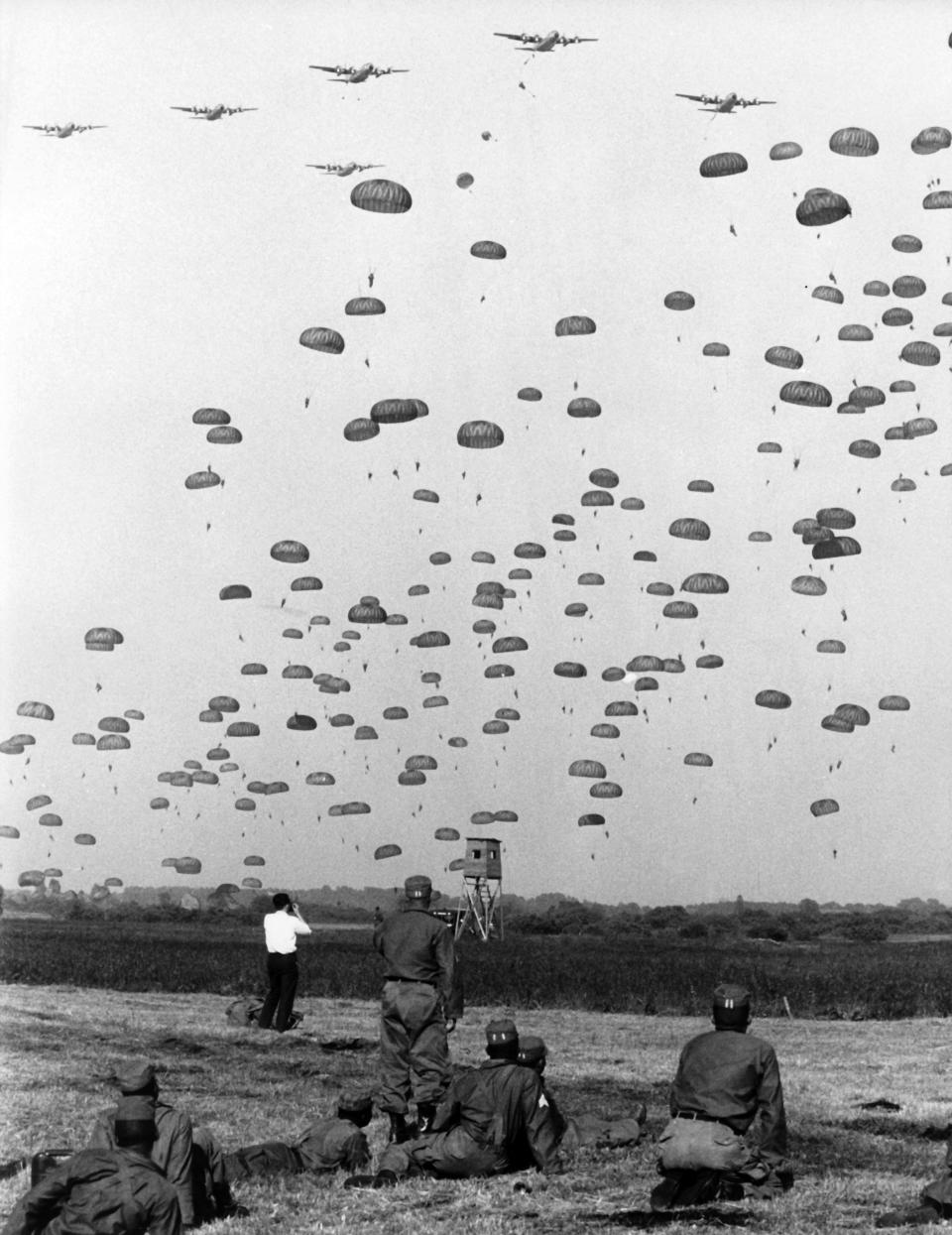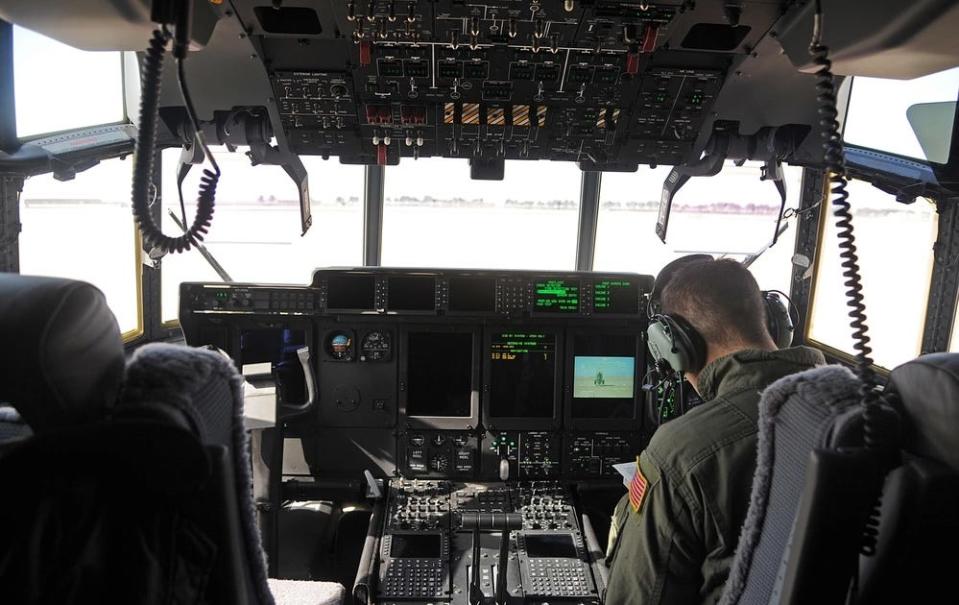Take a look at the workhorse C-130 cargo plane that the US Air Force is reinventing to fight like a bomber
The MC-130J Commando II is an upgraded version of the C-130 cargo plane.
The plane assists in infiltration, exfiltration, and resupply for special ops forces.
The US Air Force recently began utilizing the cargo plane to airdrop palletized munitions.
The C-130 cargo plane was first designed in 1951.
More than seven decades later, one of the plane's latest models, the MC-130J, is being fitted with a new weapons system that is changing how the US Air Force utilizes its fleet of existing planes.
The first of its kind

The C-130 Hercules was created to address deficiencies in the US Air Force fleet during the Korean War.
The US military recognized a need for a plane that could take off from shorter runways and transport more soldiers and supplies on and off the battlefield. At the time, no plane could simultaneously achieve all the objectives the Air Force needed.
The Air Force asked for designs for a plane capable of hauling large, bulky equipment over long distances, landing in tight spaces, slowing to 125 knots for paratroop drops, and flying with one engine if needed.
Boeing, Douglas, and Fairchild submitted models for this new type of plane, but Lockheed's submission ultimately won the bid in 1951. To this day, Lockheed still makes C-130 models and their upgraded versions.
In a 2017 interview with Popular Mechanics, Lockheed Martin historian Jeff Rhodes said the design team took the largest piece of equipment the Army needed to transport, "drew a circle around it, and that set the diameter of the fuselage."
"The basic C-130, aft of the cockpit and before the ramp, is the length of a railroad boxcar," Rhodes said.
Three years later, the YC-130, a prototype of the later C-130, made its first test flight from Burbank, California, to Edwards Air Force Base in Kern County, California. It took off after using only 855 feet of runway, a fraction of the 5,000-foot ground roll needed by most other planes its size.
The US Air Force has not stopped production of the C-130 class plane since it was invented in the 1950s, making it the longest continuous aircraft production run in history.
‘The C-130 is whatever is needed’

According to Lockheed Martin, the C-130 could originally carry 40,000 pounds of cargo and fly at 360 mph.
In the years since its creation, the performance and usage of the C-130 have exceeded expectations, and it has become known as a "do-it-all" plane.
"The C-130 is whatever is needed," Rhodes told Popular Mechanics. "It's an ambulance, it's a gunship, it drops paratroopers, it carries cargo, it's a TV broadcast system, it's launched drones, and caught satellites. You name it, the Hercules has done it at some point in its career."
In 2010 alone, the C-130 series plane hauled more than 13,600 short tons of cargo, transported more than 25,800 passengers, and routed 280 patients from Haiti for medical evaluations after the country's devastating earthquake, according to Lockheed Martin.
First of many

The C-130's high utility and versatility have contributed to its historic production run for the US Air Force. Since its creation, the plane has been in production for over 70 years.
It has roughly 70 variants, over 2,400 aircraft have been produced, and it is used by 70 countries worldwide.
Durability

In addition to its versatility and numerous variants, the C-130 is also known for its durability.
Early models of the C-130 had four different engines delivering 3,750 horsepower each. Newer models, like the MC-130J, have four Rolls-Royce AE 2100D3 Turboprop engines.
According to Wayne Roberts, Lockheed's chief experimental test pilot, the C-130 and its variants are so versatile that they can stay in flight at speeds as low as 80 knots with only one engine working.
Lockheed attributes the durability of the aircraft to using the four turboprop engines, which provide surplus power to the plane and pressurize the fuselage, including the cargo compartment. This allows the aircraft to fly efficiently at high altitudes. Lockheed strengthened the airframe to accommodate the added pressurization.
In 1971, a C-130, call sign Juliet Delta 321, crashed during a resupply mission in Antarctica after the rockets used in takeoff assistance malfunctioned. There were no casualties, but the C-130 was left in the harsh ice and snow of the Antarctic for 15 years.
After other C-130s were successfully recovered in similar incidents, plans were drawn to recover the plane 15 years later. Just over a year after operations began, Juliet Delta 321 was up in the skies again.
A habit of making history

Recovery from the Arctic is not the only time the C-130 has been in the headlines. The US Navy and the Air Force wanted to determine the feasibility of landing a C-130 on an aircraft carrier and using it as a "Super COD (Carrier Onboard Delivery)."
In 1963, the KC-130F refueler transport aircraft, a variant of the C-130, landed and took off from an aircraft carrier more than two dozen times, all while carrying a gross weight between 85,000 and 121,000 pounds.
To this day, the KC-130F is the largest and heaviest plane to ever land on an aircraft carrier.
More than just supply drops

Though the C-130's original design was intended to transport soldiers and supplies, the plane has gone on to do much more.
Its high weight limit and large cargo hold were used in missions involving environmental disasters, dropping pamphlets for CIA psyops, and rescuing people in dangerous situations.
The C-130 can also be beneficial in combat. The AC-130 has an armament of 20mm/30mm/40mm cannons, a 105mm howitzer, and additional smart bombs and missiles. During Vietnam, the C-130s carried a 15,000-pound BLU-82, the largest bomb in the US arsenal at the time.
In 2017, a C-130 dropped the GBU-43/B Massive Ordnance Air Blast (MOAB), also known as the "Mother of All Bombs," the largest conventional bomb ever used in combat, weighing in at over 20,000 pounds.
A new model of an old plane

One of the newest versions of the C-130 is the MC-130J Commando II, approved and delivered to the Air Force in 2017. The plane has four Rolls Royce AE 2100D3 Turboprops engines, can fly up to 362 knots, and can take off with a weight of 164,000 pounds.
The Commando can fly low-visibility missions, complete single or multiship low-level air refueling missions, support infiltration and exfiltration operations, and resupply special operation forces.
The MC-130J has two pilot flight stations with state-of-the-art navigation and defense systems, digital autopilot, and environmental and ice-protection systems.
The US Air Force has recently started considering how a workhorse plane like the MC-130J can be used in situations other than cargo transport.
Rapid Dragon

Rapid Dragon is an Air Force effort looking into palletized munitions designed to be released from the cargo hold of an MC-130J. The module consists of a cage that can be programmed to release and fire at a target while inside the cargo hold of the MC-130J.
Once the payload is programmed, the crew of the Commando II drops it like they would any other supplies. As the pallet floats in the parachute, the attached weapon detaches and flies off toward its target.
The versatility of the Commando II makes it the perfect aircraft for this new munition system. Adding the munitions doesn't require any extra crewmembers, training, or equipment, and it saves time since the Commando II can carry as many long-range weapons as a B-52 bomber.
"The beauty is this capability doesn't require any aircraft modifications, and it doesn't require any special crew training," Lt. Gen. Jim Slife, the head of Air Force Special Operations Command, said at an Air & Space Forces Association event in 2022. "So it's really easily exportable."
No runway, no problem

Rapid Dragon adds firepower to the already advanced Commando II, but its ability to pull off shorter takeoffs makes it even more of a threat.
Despite its size, the Commando II can take off with only 3,000 feet of runway compared to 10,000 feet or more for other planes. Not only can palletized munitions be added to their cargo during resupply at just about any location, but the planes can take off from almost anywhere, making it harder for enemies to figure out where attacks may be coming from.
"It's not hard to figure out where all the 10,000-feet concrete runways in the Pacific are, but when you're trying to figure out where the 3,000-feet straight stretches of road and grass strips are," Slife added, "that's a different targeting problem for your adversaries."
Global impact

As tests of dropping palletized munitions from cargo planes have become successful, more countries are asking AFSOC for demonstrations of the new technology, and they have started sharing the technology and techniques with other militaries.
AFSOC is also investigating ways to improve or add to the MC-130J to make it even more versatile, such as adding amphibious modifications that allow it to land and take off from bodies of water.
"If you were going to build an amphibious airplane, you probably wouldn't start with a C-130, but the C-130 is the ingredient that we've got in the cupboard," Slife said previously. "We've got a pretty compelling digital design that's going to give us the ability to turn any large body of water into a landing zone where we can insert [and] extract special-operations forces and equipment and other things that might cause dilemmas for our adversaries."
Read the original article on Business Insider


